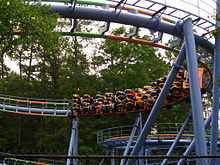Shockwave (Kings Dominion)
| Shockwave | |
|---|---|
 The vertical loop element and station building | |
| Kings Dominion | |
| Park section | Candy Apple Grove |
| Coordinates | 37°50′19″N 77°26′41″W / 37.83861°N 77.44472°WCoordinates: 37°50′19″N 77°26′41″W / 37.83861°N 77.44472°W |
| Status | Operating |
| Opening date | 1986 |
| Replaced | Galaxie |
| General statistics | |
| Type | Steel – Stand-up |
| Manufacturer | TOGO |
| Designer | TOGO |
| Model | stand-up |
| Track layout | custom |
| Height | 95 ft (29 m) |
| Drop | 84 ft (26 m) |
| Length | 2,231 ft (680 m) |
| Speed | 50 mph (80 km/h) |
| Inversions | 1 |
| Duration | 2:00 |
| Max vertical angle | 52° |
| Capacity | 960 riders per hour |
| G-force | 3.9 |
| Trains | 2 trains with 6 cars. Riders are arranged 2 across in 2 rows for a total of 24 riders per train. |
|
Shockwave at RCDB Pictures of Shockwave at RCDB | |
Shockwave is a stand-up roller coaster at Kings Dominion. Although not the first of its kind upon opening in 1986, closures elsewhere have since rendered it the oldest currently operating stand-up roller coaster in the United States.
History
The site on which Shockwave stands was formerly home to the Galaxie roller coaster, a small steel coaster of the S.D.C. Galaxi model. However, on September 11, 1983, an incident on the coaster resulted in the fatal injury of 13-year-old Daniel Watkins. The incident was used as the primary example of unsafe rides in local press coverage of the concurrent U.S. Senate hearings on amusement ride safety and regulation.[1][2] Rather than reopen the attraction, Kings Dominion dismantled and sold it, to the Myrtle Beach Pavilion where it operated until 1997 as the Galaxi.
To replace the Galaxie, Kings Dominion recruited Japanese manufacturer TOGO to build a compact steel stand-up coaster. Shockwave opened in 1986, and has run continuously since. The station design is noted for the use of an unusual technique; the station floor is not level, instead tilting down toward the front. This eliminates the need to propel dispatched trains onto the track circuit, instead relying on gravity to roll the train out of the station.

Though popular around its opening, the attraction is seen by many as a rough, uncomfortable and even painful ride. Despite this, its unique stand-up design and oldest-in-operation status have earned it a fanbase and level of popularity at the park which it maintains to this day.
Theming
The trains were painted blue with yellow restraints, and the station with natural-toned stain and paint. For the park's 25th anniversary in 2000, the entire ride was painted in non-standard scheme, neon colors. The superstructure and main rail were painted periwinkle, with the running rails alternating patches of aquamarine and orange. The trains were repainted orange, and the station in the same neon colors as the track. In 2011, they repainted Shockwave green for the tracks and teal for the supports.
Incidents
On the evening of August 23, 1999, a 20-year-old man was thrown from the train's final turn at speeds of 40 miles per hour (64 km/h) sustaining a fatal head injury upon contact with a steel walkway. Shockwave and two similar rides at other Paramount amusement parks were immediately closed. The event was originally reported as "an accident [that] resulted in the death of one park visitor,"[3] but further investigation proved otherwise. Bolstered by numerous eyewitness accounts, the cause was later attributed to the victim's disregard of park safety rules as he was seen intentionally freeing himself from restraints. In addition, an inspection found the safety restraints to be working properly at the time of the accident. Shockwave was reopened three days later on August 26, 1999.[4]
Less than two weeks later on September 2, 1999, a 13-year-old boy, concerned that he was not properly fastened into his restraints, intentionally slipped out of them as the train was ascending the lift hill. He jumped onto the adjacent maintenance catwalk and escaped serious injury.[5]
References
- ↑ Washington Post archived article on the Galaxie accident
- ↑ Washington Post archived article about the Amusement Ride Inspection Bill, mentioning the accident on Galaxie
- ↑ http://www.ultimaterollercoaster.com/news/archives/august99/stories/082499_03.html Initial Accident Report following death on Shockwave coaster
- ↑ http://www.ultimaterollercoaster.com/news/archives/august99/stories/083199_02.shtml The full report following the conclusion of the investigation
- ↑ http://www.rideaccidents.com/1999.html#sep2 The RideAccidents.com report on the 13-year-old leaving his restraints
External links
| |||||||||||